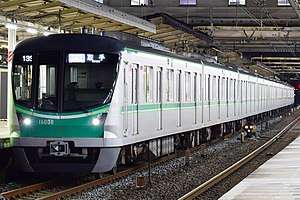Tokyo Metro 5000 series
The Tokyo Metro 5000 series (東京地下鉄5000系, Tōkyō Chikatetsu 5000-kei) is an electric multiple unit (EMU) train type first built 1964, which operated as 3-car sets on the Tokyo Metro Chiyoda Line branchline in Tokyo, Japan until 2014. 10-car sets were used on the Tokyo Metro Tōzai Line until March 2007. Some sets have also been shipped to Indonesia, where they operate on the Kereta Commuter Indonesia system in Jakarta.
| Tokyo Metro 5000 series | |
|---|---|
A Chiyoda Line 3-car set at Ayase Depot in December 2007 | |
| In service | 1964–2007 (Tozai Line) Until 2014 (Chiyoda Branch Line) (Japan) 2007–2020 (Indonesia) |
| Manufacturer | Keisha Seizo, Tokyu Car Corporation, Nippon Sharyo, Kinki Sharyo, Kawasaki Heavy Industries, Teikoku Sharyo |
| Constructed | 1964–1981 |
| Number built | 428 vehicles |
| Number preserved | 1 vehicle (Now removed) |
| Number scrapped | 397 vehicles |
| Formation | 3 cars per trainset (used for Chiyoda Branch line until 2014) 10 cars per trainset (for Tokyo Metro Tozai Line) |
| Fleet numbers | 61-62 |
| Capacity | 136 (50 seating) (end cars), 144 (54/55/58) (intermediate cars) |
| Operator(s) | Tokyo Metro (previously TRTA) (1964–2014) Kereta Commuter Indonesia (KCI) (2007–January 2020 (Regular Service)) |
| Depot(s) | Ayase (Tokyo Metro) Depok (KCI) |
| Line(s) served | Tokyo Metro: T Tokyo Metro Tozai Line, TR Tōyō Rapid Line, JB Chūō-Sōbu Line, C Tokyo Metro Chiyoda Line (Ayase Branch) KCI: KA Commuter Line Jakarta Kota–Cikarang |
| Specifications | |
| Car body construction | Stainless steel/aluminium |
| Car length | 20 m (65 ft 7 in) |
| Width | 2.87 m (9 ft 5 in) (end car), 2.856 m (9 ft 4.4 in) (stainless steel intermediate cars), 2.852 m (9 ft 4.3 in) (aluminium intermediate cars) |
| Height | 3.775 m (12 ft 4.6 in) (1st-2nd batches), 3.9 m (12 ft 10 in) (3rd batch onwards), 4.135 m (13 ft 6.8 in) (including air-conditioning), 4.145 m (13 ft 7.2 in) (including pantograph) |
| Doors | 4 per car |
| Maximum speed | 100 km/h (60 mph) |
| Traction system | Resistor control |
| Power output | 100 kW x 4 per motor car |
| Transmission | Westinghouse Natal (WN) drive; Gear ratio: 6.19 : 1 |
| Acceleration | 3.3 km/h/s |
| Deceleration | 4.0 km/h/s (5.0 km/h/s emergency) |
| Electric system(s) | 1,500 V DC |
| Current collection method | Overhead wire |
| Bogies | FS358, FS502, FS502A/B |
| Braking system(s) | Electromagnetic direct braking and dynamic braking, later regenerative braking |
| Safety system(s) | WS-ATC, CS-ATC, ATS-B, ATS-P |
| Coupling system | Shibata |
| Track gauge | 1,067 mm (3 ft 6 in) |
Chiyoda Line 3-car sets
Until 30 May 2014, two three-cars sets were in operation, sets 61 and 62. These two aluminium-bodied sets were used on the Chiyoda Line branch between Ayase and Kita-Ayase, and were formed as shown below.[1]
| Car No. | 1 | 2 | 3 |
|---|---|---|---|
| Designation | CT | M1 | CM2 |
| Numbering | 5900 | 5400 | 5100 |
Cars 2 and 3 were each fitted with one single-arm pantograph.[1]
Tozai Line 10-car sets
Ten-car 5000 series sets operated on the Tokyo Metro Tozai Line from December 1964 until March 2007. They were also used on the JR Chuo-Sobu Line between Nakano Station and Mitaka Station, between Nishi-Funabashi Station and Tsudanuma Station (weekday mornings and evenings only), and on the Tōyō Rapid Line between Nishi-Funabashi Station and Tōyō-Katsutadai Station.
Later sets had aluminium bodies.
- Tozai Line stainless steel 5000 series at Fukukawa Depot in December 2006
- Tozai Line aluminium-bodied 5000 series at Fukukawa Depot in December 2006
Interior
- Interior of Tozai Line set in June 2006
 Driver's cab of 5000 series
Driver's cab of 5000 series
Other operators
Toyo Rapid Railway
Ten former Tozai Line sets were converted in 1995 to Tōyō Rapid 1000 series EMUs for use on the Tōyō Rapid Railway extension of the Tozai Line.
Indonesia
Three former Tozai Line ten-car sets (5809, 5816, and 5817) were shipped to Indonesia in 2007, entering service with KRL Jabotabek (now Kereta Commuter Indonesia) in the Jakarta area from January 2007.[2]
The three sets were each reduced to eight-car formations on arrival in Indonesia.[2] Set 5816 was withdrawn in September 2014.[2]
Of the two remaining sets, set 5817 was lengthened to ten cars in July 2017 with the addition of two intermediate cars from former Toyo Rapid 1000 series set 1091.[2]
Set 5817 finally ended their final operation in Jakarta, Indonesia in January 2020.
During this COVID-19 pandemic Set 5817 is used temporarily for more room to practice social distancing.
 Set 5817 in Jakarta in November 2010
Set 5817 in Jakarta in November 2010 8-car set 5809 in October 2016, using revised livery
8-car set 5809 in October 2016, using revised livery 10-car set 5817 in July 2017
10-car set 5817 in July 2017
Preserved examples
- Car 5833 in Shin-Suna Ayumi Park, Koto, Tokyo
- Shin-Suna Ayumi Park in Tokyo in July 2006 9 (Removed at 2012)
References
- 私鉄車両編成表 2014 [Private Railway Rolling Stock Formations - 2014] (in Japanese). Japan: Kotsu Shimbunsha. 24 July 2014. p. 73. ISBN 978-4-330-48414-3.
- Takagi, Satoru (January 2018). ジャカルタ 東京地下鉄関連の車両 [Tokyo Metro rolling stock in Jakarta]. Japan Railfan Magazine (in Japanese). Vol. 58 no. 681. Japan: Koyusha Co., Ltd. p. 124.
External links
| Wikimedia Commons has media related to Tokyo Metro 5000 series. |
- Tokyo Metro Chiyoda Line 5000/6000 series information (in Japanese)
